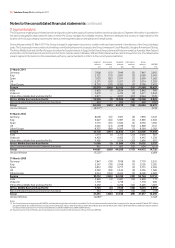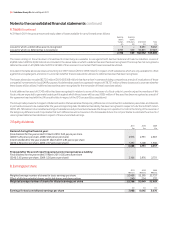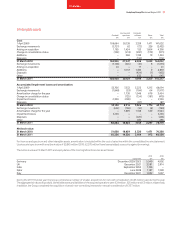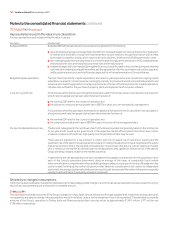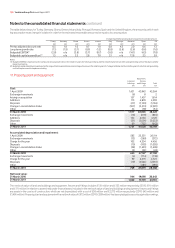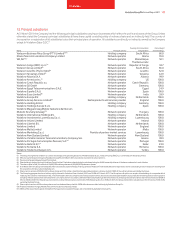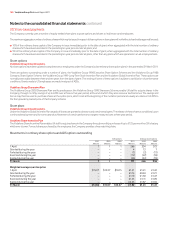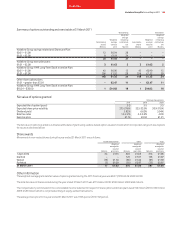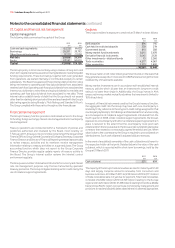Vodafone 2011 Annual Report Download - page 102
Download and view the complete annual report
Please find page 102 of the 2011 Vodafone annual report below. You can navigate through the pages in the report by either clicking on the pages listed below, or by using the keyword search tool below to find specific information within the annual report.
100 Vodafone Group Plc Annual Report 2011
Notes to the consolidated nancial statements continued
10. Impairment continued
Key assumptions used in the value in use calculations
The key assumptions used in determining the value in use are:
Assumption How determined
Budgeted EBITDA Budgeted EBITDA has been based on past experience adjusted for the following:
■voice and messaging revenue is expected to benefit from increased usage from new customers, the introduction
of new services and traffic moving from fixed networks to mobile networks, though these factors will be offset
by increased competitor activity, which may result in price declines, and the trend of falling termination rates;
■non-messaging data revenue is expected to continue to grow strongly as the penetration of 3G enabled devices
and smartphones rises and new products and services are introduced; and
■margins are expected to be impacted by negative factors such as an increase in the cost of acquiring and retaining
customers in increasingly competitive markets and the expectation of further termination rate cuts by regulators
and by positive factors such as the efficiencies expected from the implementation of Group initiatives.
Budgeted capital expenditure The cash flow forecasts for capital expenditure are based on past experience and include the ongoing capital
expenditure required to roll out networks in emerging markets, to provide enhanced voice and data products and
services and to meet the population coverage requirements of certain of the Group’s licences. Capital expenditure
includes cash outflows for the purchase of property, plant and equipment and computer software.
Long-term growth rate For businesses where the five year management plans are used for the Group’s value in use calculations, a long-term
growth rate into perpetuity has been determined as the lower of:
■the nominal GDP rates for the country of operation; and
■the long-term compound annual growth rate in EBITDA in years six to ten estimated by management.
For businesses where the plan data is extended for an additional five years for the Group’s value in use calculations,
a long-term growth rate into perpetuity has been determined as the lower of:
■the nominal GDP rates for the country of operation; and
■the compound annual growth rate in EBITDA in years nine to ten of the management plan.
Pre-tax risk adjusted discount rate The discount rate applied to the cash flows of each of the Group’s operations is generally based on the risk free rate
for ten year bonds issued by the government in the respective market. Where government bond rates contain
a material component of credit risk, high quality local corporate bond rates may be used.
These rates are adjusted for a risk premium to reflect both the increased risk of investing in equities and the
systematic risk of the specific Group operating company. In making this adjustment, inputs required are the equity
market risk premium (that is the required increased return required over and above a risk free rate by an investor
who is investing in the market as a whole) and the risk adjustment, beta, applied to reflect the risk of the specific
Group operating company relative to the market as a whole.
In determining the risk adjusted discount rate, management has applied an adjustment for the systematic risk to
each of the Group’s operations determined using an average of the betas of comparable listed mobile
telecommunications companies and, where available and appropriate, across a specific territory. Management has
used a forward-looking equity market risk premium that takes into consideration both studies by independent
economists, the average equity market risk premium over the past ten years and the market risk premiums typically
used by investment banks in evaluating acquisition proposals.
Sensitivity to changes in assumptions
Other than as disclosed below, management believes that no reasonably possible change in any of the above key assumptions would cause the carrying
value of any cash generating unit to exceed its recoverable amount.
31 March 2011
The estimated recoverable amounts of the Group’s operations in Italy, Spain, Greece, Ireland and Portugal equalled their respective carrying values and,
consequently, any adverse change in key assumptions would, in isolation, cause a further impairment loss to be recognised. The estimated recoverable
amounts of the Group’s operations in Turkey, India and Ghana exceeded their carrying values by approximately £1,481 million, £977 million and
£138 million, respectively.


